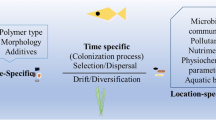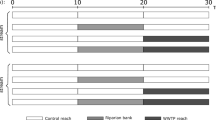Abstract
The effects of inorganic mercury (HgII) and methylmercury (MeHg) on the colonization of artificial substrates by periphytic diatoms were studied using indoor freshwater microcosms. These consisted of a mixed biotope– water column + natural sediment – with rooted macrophyte cuttings (Elodea densa) and benthic bivalve molluscs (Corbicula fluminea).The periphyton was collected on glass slides in the water column after 34and 71 days. The two Hg sources were introduced either by daily additions to the water column, or once at the beginning into the sediment, using two nominal concentrations: water column, 0.5 μgL-1 and 2 μg L-1 for both compounds: sediment, 0.5 mg kg-1 (fw) and 2 mgkg-1 (fw) for MeHg and 1 mg kg-1 (fw) and 10 mgkg-1 (fw) for HgII. Several complementary criteria were used to analyse the structural and functional perturbations induced: cell density, species richness, diatom size, relative abundance. Exposure to MeHg added to the water column resulted in reduced cell density and changes in species composition with enhancement of e.g. Fallacia pygmaea or Nitzschia palea; inorganic Hg had less effect on the population structure. After contamination via the sediment, the effects of the two compounds were less pronounced than for the water source.
Similar content being viewed by others
References
Acs E, Kiss KT (1993) Colonization processes of diatoms on artificial substrates in the River Danube near Budapest, Hungary. Hydrobiologia 269/270: 307–315.
Besch WK, Ricard M, Cantin R (1972) Benthic diatoms as indicators of mining pollution in the Northwest Miramichi River System, New Brunswick, Canada. Int. Revue ges. Hydrobiol. 57: 39–74.
Bienvenue E, Boudou A, Desmazàs JP, Gavach C, Georgescauld D, Sandeaux J, Sandeaux R, Seta P (1984) Transport of mercury compounds across bimolecular lipid membranes: effect of lipid composition, pH and chloride concentration. Chem. Biol. Interactions 48: 91–101.
Boudou A, Ribeyre F (1985) Experimental study of trophic contamination of Salmo gairdneriby twomercury compounds: analysis at the organism and organ levels. Wat. Air Soil Pollut. 26: 137–148.
Britton JC, Morton B (1982) A dissection guide, field and laboratory manual for the introduced bivalve Corbicula fluminea. Malacol. Rev. 3: 1–82.
Cloutier-Mantha L, Brown DA (1980) The effects of mercury exposure on intracellular distribution of mercury, copper and zinc in Skeletonema costatum (Grev.) Cleve. Bot. mar. 23: 53–58.
Coste M, Bosca C, Dauta A (1991) Use of algae for monitoring rivers in France. In Whitton BA, Rott E & Friedrich G (eds) Use of Algae for Monitoring Rivers, Universität Innsbruck: 75–88.
De Filippis LF (1989) Toxicity and resistance of algae to heavy metals. In Ozturk MA (ed.), Plants and Pollutants in Developed and Developing Countries. Ege Univ. Press, Izmir: 1935.
De Filippis LF, Pallaghy CK (1994) Heavy metals: Sources and biological effects. Arch. Hydrobiol. 42: 31–77.
De Noyelles F, Kettle WD, Sinn DE (1982) The responses of plankton communities in experimental ponds to atrazine, the most heavily used pesticide in the United States. Ecology 63: 1285–1293.
Delnomdedieu M, Boudou A, Georgescauld D, Dufourc EJ (1992) Specific interactions of mercury chloride with membranes and other ligands as revealed by mercury-NMR. Chem. Biol. Interactions 81: 243–269.
Farey BJ, Nelson LA, Rolph MG (1978) Rapid technique for the breakdown of organic mercury compounds in natural waters and effluents. Analyst 103: 656–659.
Fujita M, Hashizume K (1975) Status of uptake of mercury by the freshwater diatom, Synedra ulna. Wat. Res. 9: 889–894.
Genter RB, Cherry DS, Smith EP, Cairns J, Jr (1987) Algalperiphyton population and community changes from zinc stress in stream mesocosms. Hydrobiologia 153: 261–275.
Girault L, Lemaire P, Boudou A, Dufourc L (1994) Interactions of inorganic mercury with micellar phospholipid headgroups: a 31P-NMR study. Wat. Air Soil Pollut. 80: 95–98.
Guanzon NG, Nakahara JH, Yoshida Y (1994) Inhibitory effects of heavy metals on growth and photosynthesis of three freshwater microalgae. Fish. Sci. 60: 379–384.
Gutknecht J (1981) Inorganic mercury (Hg2+) transport through lipid bilayers membranes. J. Memb. Biol. 61: 61–66.
Harris RC, White DB, Macfarlane RB (1970) Mercury compounds reduce photosynthesis by plankton. Science 170: 736–737.
Hoagland KD, Roemer SC, Rosowski JR (1982) Colonization and community structure of two periphyton assemblages, with emphasis on the diatoms (Bacillariophyceae). Am. J. Bot. 69: 188–213.
Hofmann G (1994) Aufwuchs Diatomeen in Seen und ihre Eignung als Indikatoren der Trophie. Bibl. Diatomol. 30: 1–241.
Inza B, Ribeyre F, Maury-Brachet R, Boudou A (1997) Tissue distribution of inorganic mercury, methylmercury and cadmium in the asiatic clam (Corbicula fluminea) in relation to the contamination levels of the water column and sediment. Envir. Sci. Pollut. Res. Int. (in press).
Krammer K, Lange-Bertalot H (1986–1991) Bacillariophyceae 1 Teil: Naviculaceae, 876 pp.; 2 Teil: Bacillariaceae, Epithemiaceae, Surirellaceae, 596 pp.; 3 Teil: Centrales, Fragilariaceae, Eunotiaceae, 576 pp.; 4 Teil: Achnanthaceae. Kritische Ergänzungen zu Navicula (Lineolatae) und Gomphonema. 437 pp. In Ettl H, Gerloff J, Heinig H, Mollenhauer D (eds), Süßwasserflora von Mitteleuropa 2(1–4) G Fisher Verlag, Stuttgart.
Krupa Z, Baszynski T (1995) Some aspects of heavy metals toxicity towards photosynthetic apparatus–direct and indirect effects on light and dark reactions. Act. Physiol. Plant. 17: 177–190.
Kuiper J (1981) Fate and effects ofmercury inmarine plankton communities in experimental enclosures. Ecotoxicol. envir. Safety 5: 106–134.
Lakowicz JR, Anderson CJ (1980) Permeability of lipid bilayers to methylmercuric chloride: quantification by fluorescence quenching of a carbazole-labeled phospholipid. Chem. Biol. Interactions 30: 309–323.
Lange-Bertalot H (1979) Pollution tolerance of diatoms as a criterion for water quality estimation. Nova Hedwigia 64: 285–304.
Lecointe C, Coste M, Prygiel J (1993) ‘OMNIDIA’ software for taxonomy, calculation of diatom indices and inventories management. Hydrobiologia 269/270: 509–513.
Mason RP, Reinfelder JR, Morel FMM (1995) Uptake, toxicity, and trophic transfer of mercury in a coastal diatom. Envir. Sci. Technol. 30: 1835–1845.
Maury-Brachet R, Ribeyre F, Boudou A (1990) Actions and interactions of temperature and photoperiod on mercury accumulation by Elodea densafrom sediment source. Ecotoxicol. Envir. Safety 10: 141–155.
McCormick P, Cairns J, Jr (1994) Algae as indicators of environmental change. J. appl. Phycol. 6: 509–526.
Odin M, Feurtet-Mazel A, Ribeyre F, Boudou A (1995) Inorganic mercury and methylmercury bioaccumulation by nymphs of the burrowing mayfly Hexagenia rigidafrom the water column as the initial contamination source. Quantification of the actions and interactions with temperature, pH and photoperiod. Toxicol. environ. Chem. 48: 213–244.
Patrick R (1978) Effects of trace metals in the aquatic ecosystem. Am. Sci. 66: 185–191.
Pérès F, Florin D, Grollier T, Feurtet-Mazel A, Coste M, Ribeyre F, Ricard M, Boudou A (1996) Effects of the phenylurea herbicide Isoproturon on periphytic diatom communities in freshwater indoor microcosms. Envir. Pollut. 94: 141–152.
Ribeyre F, Boudou A (1989) Trophic chains and experimental ecosystems: study of bioaccumulation and transfer processes. In Ribeyre F, Boudou A (eds), Aquatic Ecotoxicology: Fundamental Concepts and Methodologies. CRC Press, Boca-Raton: 3–46.
Ribeyre F (1991) Experimental ecosystems: comparative study of two methods of contamination of the water column by mercury compounds in relation to bioaccumulation of the metal by rooted macrophytes (Ludwigia natans). Environ. Tech. 12: 503–518.
Round FE, Crawford RM, Mann DG (1990) The Diatoms. Biology and Morphology of the Genera. Cambridge Univ. Press, Cambridge, 747 pp.
Rushforth SR, Brotherson JD, Fungladda N, Evenson WE (1981) The effects of dissolved heavy metals on attached diatoms in the Uintah basin of Utah, U.S.A. Hydrobiologia 83: 313–323.
Snedecor GW, Cochran WG (1971) Méthodes Statistiques. Ass. Coord. Tech. Agr., Paris, 412 pp.
Symoens JJ, Kusel-Fetzmann E, Descy J-P (1988) Algal communities of continental waters. In Symoens JJ (ed.), Vegetation of Inland Waters. Kluwer Acad. Publ., Dordrecht: 183–221.
Van Dam H, Mertens A, Sinkeldam J (1994) A coded checklist and ecological indicator values of freshwater diatoms from the Netherlands. Neth. J. aquat. Ecol. 28: 117–133.
Venrick EL (1978) How many cells to count? In Sournia A (ed.), Phytoplankton Manual. UNESCO, Paris: 167–180.
Whitton BA, Kelly MG (1995) Use of algae and other plants for monitoring rivers. Austr. J. Ecol. 20: 45–56.
Author information
Authors and Affiliations
Rights and permissions
About this article
Cite this article
Pérès, F., Coste, M., Ricard, F. et al. Effects of methylmercury and inorganic mercury on periphytic diatom communities in freshwater indoor microcosms. Journal of Applied Phycology 9, 215–227 (1997). https://doi.org/10.1023/A:1007960506716
Issue Date:
DOI: https://doi.org/10.1023/A:1007960506716




